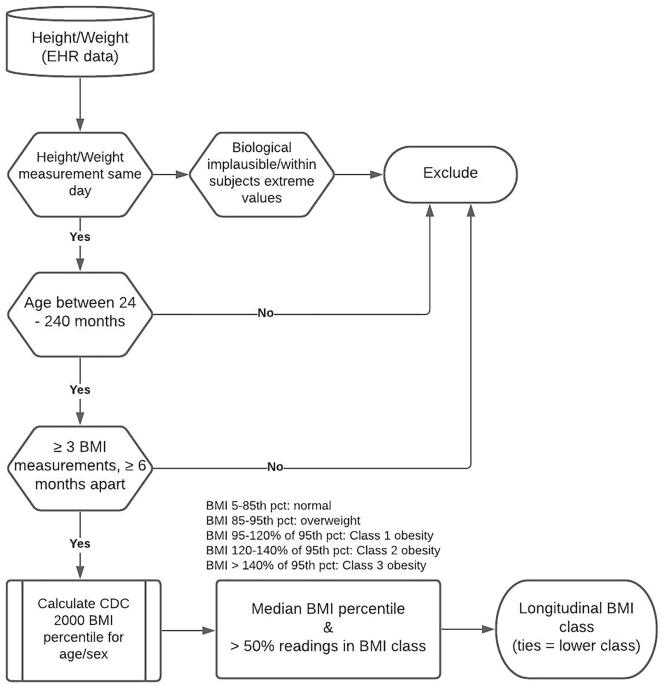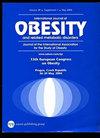Classification of childhood obesity using longitudinal clinical body mass index and its validation
IF 3.8
2区 医学
Q1 ENDOCRINOLOGY & METABOLISM
引用次数: 0
Abstract
Persistence of childhood adiposity is known to be associated with long-term adverse cardiometabolic risks. Yet, cross-sectional body mass index (BMI) is often used to classify obesity in clinical care and research. This study aimed to develop and validate a childhood BMI classification system using real life longitudinal clinical data. This observational study used electronic health record data from a tertiary care hospital, with replication in an independent cohort. For individuals with ≥ 3 BMI measurements, the median BMI percentile and persistence in the obesity class were used for longitudinal classification. The association between longitudinal BMI class and early onset obesity, socioeconomic status (SES), and adverse cardiometabolic risk was analyzed. Height, weight, and cardiometabolic risk measures were obtained for 22,352 children from 2014–18 in the primary cohort and 24,444 children in the replication cohort. Obesity (BMI ≥ 95th percentile [BMIpct95]) was observed in 24.1% and severe obesity (BMI ≥ 120% of BMIpct95) in 10.6%. Individuals with early onset obesity (age ≤ 6 years) remained in the same or higher obesity class; those in the high-SES group had lower odds of obesity. The proportion of individuals with cardiometabolic risk increased with obesity severity (p-value 0.01 - < 0.001). The AUC for cardiometabolic risk by longitudinal BMI class was higher compared to that for cross-sectional BMI (80.0% vs. 75.8%, p < 0.001). The Longitudinal BMI classification may better reflect long-term cardiometabolic risk in children. This classification can be useful for focused intervention strategies and for profiling of individuals for genetic testing.

儿童肥胖的纵向临床体重指数分类及其验证。
目的:儿童期持续肥胖与长期不良心脏代谢风险相关。然而,在临床护理和研究中,经常使用横断面体重指数(BMI)来对肥胖进行分类。本研究旨在利用真实生活的纵向临床数据开发和验证儿童BMI分类系统。方法:这项观察性研究使用了一家三级医院的电子健康记录数据,并在一个独立队列中进行了重复研究。对于BMI≥3的个体,采用BMI百分位数中位数和肥胖类别持续时间进行纵向分类。分析纵向BMI等级与早发性肥胖、社会经济地位(SES)和不良心脏代谢风险之间的关系。结果:获得了2014-18年主要队列22352名儿童的身高、体重和心脏代谢风险指标,复制队列24444名儿童的身高、体重和心脏代谢风险指标。肥胖(BMI≥95百分位[BMIpct95])占24.1%,重度肥胖(BMI≥120% [BMIpct95])占10.6%。早发性肥胖个体(年龄≤6岁)仍处于相同或更高的肥胖级别;高社会经济地位组的人肥胖的几率较低。有心脏代谢危险的个体比例随着肥胖严重程度的增加而增加(p值0.01 - < 0.001)。纵向BMI分类的心脏代谢风险AUC高于横断面BMI (80.0% vs. 75.8%, p)结论:纵向BMI分类可能更好地反映儿童的长期心脏代谢风险。这种分类可以用于集中干预策略和基因检测的个体分析。
本文章由计算机程序翻译,如有差异,请以英文原文为准。
求助全文
约1分钟内获得全文
求助全文
来源期刊

International Journal of Obesity
医学-内分泌学与代谢
CiteScore
10.00
自引率
2.00%
发文量
221
审稿时长
3 months
期刊介绍:
The International Journal of Obesity is a multi-disciplinary forum for research describing basic, clinical and applied studies in biochemistry, physiology, genetics and nutrition, molecular, metabolic, psychological and epidemiological aspects of obesity and related disorders.
We publish a range of content types including original research articles, technical reports, reviews, correspondence and brief communications that elaborate on significant advances in the field and cover topical issues.
 求助内容:
求助内容: 应助结果提醒方式:
应助结果提醒方式:


